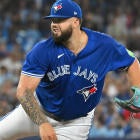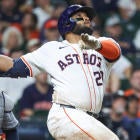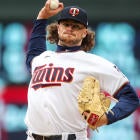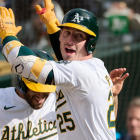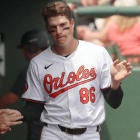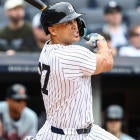Last month, I ranked 14 top rookie hitters in order of their keeper value in Fantasy. Now I'm getting around to ranking this year's rookie starting pitchers in terms of their future value. Among the top-ranked of these 18 hurlers are those who merit consideration in leagues where you may only have half a dozen or so keepers, while those towards the bottom are strictly for dynasty leagues in which you can protect a much larger number of players.
Why did I rank 18 pitchers as compared to the 14 hitters I featured in my earlier column? I had a harder time finding a cutoff point among this rookie cohort. I could have taken it further, as Jarred Cosart, Brad Peacock and Andre Rienzo missed the cut, and I left out Carlos Martinez and Trevor Rosenthal on the technicality that they were used primarily (or in Rosenthal's case, exclusively) as relievers.
Remember, these are rankings based on keeper value, so the pitchers who performed the best this year aren't necessarily the best bets to deliver value in 2014 and beyond. Based on this season's Fantasy stats as well as current and past skill indicators, here's how I would prioritize keeping starters for the years ahead.
Note: All stats are current for games played through Tuesday, Sept. 10.
1. Jose Fernandez, Marlins: I had Fernandez pretty far down my list of rookie pitchers at the start of the season, even after he cracked the Marlins' rotation due to a couple of last-minute openings. Though I appreciated Fernandez's potential, I had no idea he would make such a huge impact coming straight out of the Florida State League. Right away, he has provided well over a strikeout per inning and great command. If there's a reason to expect a slight downturn, it's that he may not replicate a 1.19 home ERA, as pitcher-friendly as Marlins Park is, or a .246 BABIP. Still, Fernandez is a worthy keeper in just about any format.
2. Julio Teheran, Braves: After struggling to get whiffs last season at Triple-A Gwinnett, Teheran got his swing-and-miss mojo back with the Braves, and he sharpened his control as well. If he can continue to maintain a low walk rate (2.4 BB/9 this year), Teheran could have a lower WHIP than Fernandez next season, even though the Marlins' rookie is besting him 0.97 to 1.20. Because Teheran leans towards being a flyball pitcher who gets his fair share of popups, he should be able to improve on his .297 BABIP. He probably won't match Fernandez for strikeouts or ERA, but in overall value, Teheran shouldn't be far behind.
3. Tony Cingrani, Reds: No secondary pitches? No problem, as Cingrani has a 2.92 ERA, even though no starting pitcher with at least 100 innings has thrown a higher percentage of fastballs, according to PitchFX data on FanGraphs.com. Higher-than-average walk (3.7 BB/9) and flyball (40 percent) rates could make Cingrani more vulnerable than Fernandez or Teheran at times, especially in his starts at Great American Ball Park, but he allows so little contact that the damage to his Fantasy stats should be minimal. With the back spasms that knocked him out of Tuesday's start against the Cubs, Cingrani might not have much value for the rest of this season, but he's worth keeping in most formats for next year and beyond.
4. Gerrit Cole, Pirates: Here's where the ranking process got interesting. Because Cole failed to achieve even an average strikeout rate, both at Triple-A Indianapolis and Pittsburgh, some owners consider him to be a disappointment. Over his eight most recent starts, Cole has struck out 46 batters in 49 2/3 innings while getting whiffs on 10 percent of his pitches. The former UCLA standout and No. 1 overall pick may not need a high K-rate to succeed, but his recent stretch and earlier minor league numbers suggest he could be capable of achieving it. If not, Cole could still be a superb control pitcher with strong ground ball tendencies, like Doug Fister. That's the lowest expectation owners should have for Cole going into next season.
5. Alex Wood, Braves: Wood's strong rookie campaign has lost some steam, as his velocity has dipped over his last four starts, and strikes have been harder to come by. The lefty has a limited track record as a starter, even in the minor leagues, but he was dominant as a reliever, and he fared well over his first six starts with the Braves. Wood hasn't had many issues with control over his brief professional career, so his recent stretch, in which he has walked 11 batters over 18 2/3 innings, should not deter owners from keeping him in 12-team mixed league formats with 10 or more protection slots.
6. Shelby Miller, Cardinals: Strikeouts have never been a problem for Miller, but he has been plagued at times by too many walks and home runs. Miller coasted through mid-June, as he allowed only 19 walks and six homers through the first 86 1/3 innings of the season. Since then, it's been a different story, as his BB/9 ratio had more than doubled and his HR/9 ratio had nearly tripled prior to Tuesday's scoreless start against the Brewers. The early part of Miller's season has shown us what he is capable of, but the more recent portion shows us the potential risks of keeping him. Given that Miller has issues with control and frequent flyballs before, it's difficult to just write them off as the passing struggles of a young pitcher.
7. Michael Wacha, Cardinals: To go by Wacha's track record as a professional, he would seem to be a more valuable keeper than Miller, but he is less of a known quantity. While Miller produced three full seasons of work in the minors before playing his first full year in the majors, Wacha has all of 152 1/3 innings between the minors and majors. Wacha, like Miller, has had sporadic problems with control, and he is also prone to allowing flyballs. He also hasn't shown the same knack for getting strikeouts, but the differences in their peripherals are not substantial. My preference for Miller over Wacha is simply based on his having a longer track record, but both pitchers need to be protected in many keeper formats.
8. Kevin Gausman, Orioles: If I had made this list during the first half of the season, Gausman probably would have ranked among the top three or four. After prospering during an eight- game stint at Double-A Bowie, Gausman has been less than impressive both at Triple-A Norfolk and in Baltimore. Though we're still dealing with a small sample of innings, his performance raises some doubts about his keeper value. On the positive side, Gausman has a healthy 11 percent whiff rate with the O's, and he is likely to improve on a 61 percent strand rate, which has contributed to his 6.30 ERA. Still, FIP projects that Gausman would have a 4.75 ERA with better luck, and I have to admit, the Orioles' recent track record with highly-touted pitching prospects makes me a little nervous.
9. Zack Wheeler, Mets: Prior to the start of the season, I projected Wheeler would finish with a 3.96 ERA, so his actual 3.38 mark has caused me to reconsider his long-term value. Wheeler did come out of the gate with the control issues that I expected from him, but he put together a recent five-game stretch in which he threw strikes consistently and issued only six walks over 32 1/3 innings. If Wheeler can sustain that kind of control, he could make good on his top-of-the-rotation potential, but I worry that he could cycle through period of good and bad walk rates, much like Jeff Samardzija has.
10. Danny Salazar, Indians: Throws really hard. Makes batters look as if they're hitting with a fly swatter. Rarely misses the strike zone. Based on what we've seen this year, Salazar has as much upside as anyone on this list (even Fernandez), but how will he do once he's allowed to pitch more than four or five innings with regularity? That uncertainty keeps Salazar from being a must-keep pitcher, but there are still plenty of formats in which he will be worth protecting.
11. Dan Straily, Athletics: Straily's stats have been nothing special this season, but there are still signs that he could have a major breakout at any time. It's actually a bit of a mystery as to why Straily owns a pedestrian 7.3 K/9 ratio, when he's been getting whiffs on 12 percent of his pitches, and his past history suggests he can whittle down his 3.2 BB/9 ratio. With a 37 percent ground ball rate, it's not surprising that Straily has been amenable to allowing homers away from O.co Coliseum, as he has yielded 10 of them in 73 road innings. That could be a chronic issue, but we should at least expect Straily to dramatically improve his 3.82 home ERA.
12. Sonny Gray, Athletics: During his brief time in the majors, Gray has been the more successful of the A's rookie starters. While Straily had the more impressive season in the minors last season, it's Gray who has delivered the better results during his brief time in the majors. He has already established himself as the superior ground ball pitcher, and if he can keep up his strikeout per inning pace, he will surpass Straily in terms of Fantasy value. Since Gray's major league track record is all of 43 innings long and he doesn't possess whiff rates as impressive as Straily's, it's premature to leapfrog him over his more experienced teammate in these rankings.
13. Hyun-Jin Ryu, Dodgers: The elder statesman of this group, Ryu is tied with Miller for the most wins (13) of any pitcher in this rookie class. Ryu ranks just 14th among rookie qualifiers in K/9 ratio (7.5), but he's been able to overcome that by limiting walks (2.5 BB/9) and homers (0.7 HR/9). Because Ryu has stranded 78 percent of his baserunners -- a rate he won't likely repeat with regularity -- he has probably been a little fortunate to have an ERA that's barely peeking above the 3.00 line. He still can have some Kris Medlen-type appeal, but without the drama over whether he'll be delegated to a bullpen role.
14. Chris Archer, Rays: Archer hasn't been the type of pitcher that his minor league numbers led us to believe he would be, but that's turned out to be a good thing. The hard-throwing 24-year-old has gone from being a wild pitcher with strikeout potential to the Sunbelt's version of Gerrit Cole. Through his first eight starts this year, Archer had walked nearly a batter every other inning, but in 11 starts since then, he's issued only 13 bases on balls over 67 1/3 innings. With a 6.0 K/9 over that period, Archer has been subpar as a strikeout pitcher, but improved control has enabled him to post a 2.94 ERA and 1.01 WHIP since his transformation. If we could trust that the change is a lasting one, it would be safe to rank him above Ryu and possibly Straily and Gray, too, but it's hard to elevate Archer based on an 11-game trend.
15. Kyle Gibson, Twins: What is a pitcher who earned a minor league demotion with a 6.53 ERA and 1.75 WHIP doing on this list? Some prospects who eventually do well get their major league careers off on the wrong foot, and I think that was the case with Gibson. He certainly could have had better control, and his minor league stats tell us that this is the one thing we should have been able to count on. Gibson also had a respectable 9 percent swinging strike rate, and while that doesn't bode well for a high strikeout rate, it means we can expect more than a 5.1 K/9. He did do a good job of inducing grounders, posting a 51 percent rate, and Gibson can't be faulted for allowing a .340 batting average on those ground balls. He could wind up succeeding more than Archer as a pitcher who gets by through limiting walks and extra-base hits.
16. Martin Perez, Rangers: Perez hasn't put up big strikeout numbers since Double-A, so it's not much of surprise that he hasn't done so this year. His stock his risen, though, as he -- like Archer -- has remade himself as a control artist. While Perez should be kept in deeper dynasty leagues, there is a strong chance that his production will fall off next season. His 9-4 record has been helped by 5.9 runs of support per nine innings, which is the third-highest rate among pitchers with at least 80 innings. Perez could also see his 3.60 ERA rise, as xFIP projects that it would be over half a run higher with less help from luck and defense.
17. Wily Peralta, Brewers: Peralta started the season looking like a young version of Jake Westbrook. Though he got his share of grounders, Peralta's command was shaky, and it showed up in his ERA and WHIP. Since June 21, however, Peralta has found the strike zone more regularly, and he has struck out a distinctly un-Westbrook-like 7.2 batters per nine innings. His 1.19 WHIP over that period might be about as good as it gets, barring a reduction in walks, but Peralta is now missing enough bats to be a threat (in a good way) in the ERA and wins categories.
18. Tyler Skaggs, Diamondbacks: Though Skaggs doesn't throw hard, he has been fairly consistent in delivering strikeouts at every level. He has had some low-grade problems with control and some monumental issues with home runs during his stints with the Diamondbacks. While he was highly flyball-prone during his brief trial with the Snakes last year, the same cannot be said for this year's seven starts, but 16 percent of his flyballs have left the park. That's a rate that should improve over time, and if all breaks well, Skaggs could be a more productive pitcher in Fantasy than several of those included on this list. We just need a bigger sample size to determine whether he will be a safe bet to reduce the .451 slugging percentage he's allowed to date over his big league career.
Stay in touch with the most passionate Fantasy staff in the business by following us on Twitter @CBSFantasyBB or Al Melchior at @almelccbs . You can also e-mail us at fantasybaseball@cbsinteractive.com .













